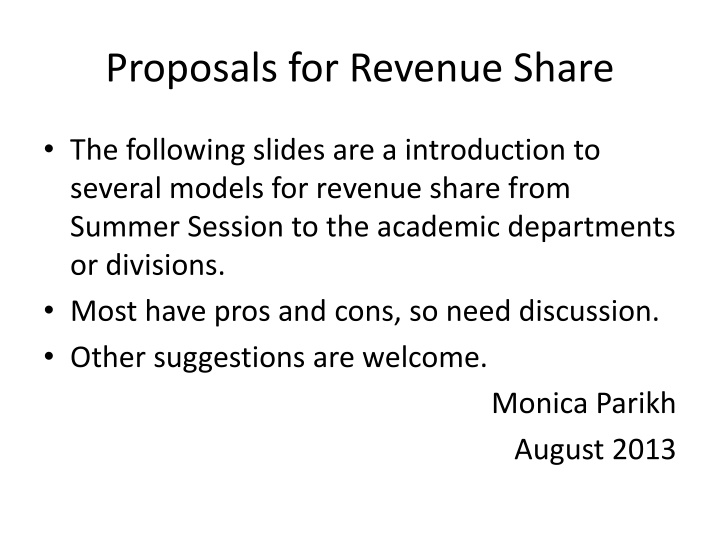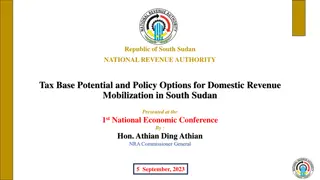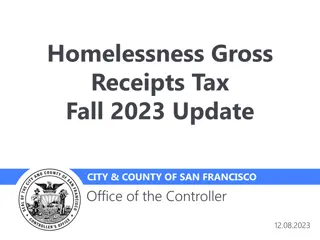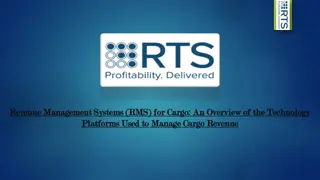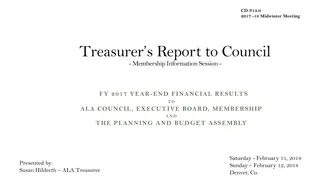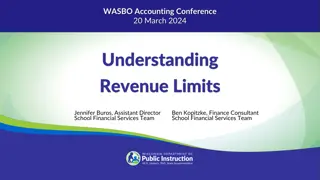Proposals for Revenue Share
Explore various models for revenue sharing among academic departments or divisions. Consider pros, cons, and alternatives presented. Analyze existing incentives and proposed options, including per student-unit rates and percentage allocations to different divisions based on units. Evaluate how these models align with goals, capacity, and quality considerations.
Download Presentation

Please find below an Image/Link to download the presentation.
The content on the website is provided AS IS for your information and personal use only. It may not be sold, licensed, or shared on other websites without obtaining consent from the author.If you encounter any issues during the download, it is possible that the publisher has removed the file from their server.
You are allowed to download the files provided on this website for personal or commercial use, subject to the condition that they are used lawfully. All files are the property of their respective owners.
The content on the website is provided AS IS for your information and personal use only. It may not be sold, licensed, or shared on other websites without obtaining consent from the author.
E N D
Presentation Transcript
Proposals for Revenue Share The following slides are a introduction to several models for revenue share from Summer Session to the academic departments or divisions. Most have pros and cons, so need discussion. Other suggestions are welcome. Monica Parikh August 2013
Example Classes for Modeling Art 32 Photography Biology 105 Genetics Biology 100k Biochemistry LAB Literature 190A Los Angeles Math 11A Calculus Music 80V Beatles Philosophy 14 Nihilism & Film (2units) Psychology 1
2012 Course Students Instructor Salary TA, Reader/Grader, & Class Costs Total Cost Art 32 13 6224 600 6824 Bio 105 99 10,983 5,246 5,556.84 Bio 100k LAB 60 8,519 8,121 16,640 Lit 190A 12 8,367 0 8,367 Math 11A 32 3,395 2,706 6,101 Music 80V 56 13,844 2,326 16,467 Phil 14 62 3,395 1,973 5,368 Psych 1 84 12,833 5,310.22 18,143.22
Existing Incentive - $5 per student-unit Art 32 13 students x 5 units x $5 = 325 Bio 105 99 students x 5 units x $5 = 2475 Bio 100k LAB 60 students x 2 units x $5 = 600 Lit 190A 12 students x 5 units x $5 = 300 Math 11A 32 students x 5 units x $5 = 800 Music 80V 56 students x 5 units x $5 = 1400 Phil 14 62 students x 2 units x $5 = 620 Psych 1 84 students x 5 units x $5 = 2100
Option 1 - $10 per student-unit Art 32 13 students x 5 units x $10 = 650 Bio 105 99 students x 5 units x $10 = 4950 Bio 100k LAB 60 students x 2 units x $10 = 1200 Lit 190A 12 students x 5 units x $10 = 600 Math 11A 32 students x 5 units x $10 = 1600 Music 80V 56 students x 5 units x $10 = 2800 Phil 14 62 students x 2 units x $10 = 1240 Psych 1 84 students x 5 units x $10 = 4200
Option 2 percent to division in proportion to percent of units With a revenue share of $300,000*: Arts 16% of units - $48,000 Engineering 9% of units - $27,000 Humanities 18% of units - $54,000 PB Science 18% of units - $54,000 Soc Science 37% of units - $111,000 *Used for example - this amount could be changed. CON: Doesn t assess quality or capacity or needs.
Option 3 percent to division in proportion to percent of enrollments With a revenue share of $300,000*: Arts 11% of enrollments - $33,000 Engineering 12% - $36,000 Humanities 12% - $36,000 PB Science 28% - $84,000 Soc Science 35% - $105,000 *Used for example - this amount could be changed.
Option 4 courses that exceed their allocation receive no revenue share $11,227 allocated per course That s the 2012 instructional budget divided by number of courses offered Each course is evaluated separately Course cost $11,227 If positive, allocation exceeded. Not eligible for revenue share to department. If negative, allocation unmet, revenue is shared. [35 of our 200+ courses from 2012 exceeded this allocation] [Almost half of those were labs]
Option 5 departments who exceed allocation receive no revenue share $11,227 allocated per course That s the 2012 instructional budget divided by number of courses offered $11,227 times number of classes Sum of departments course costs allocation If positive, revenue shared. If negative (exceeded allocation), no revenue shared. [Only four departments from 2012 exceeded this allocation: AMS, BIOL, CHEM, and PHYS our highest lab-offering departments]
Option 6 revenue share commensurate with enrollment $X allocated per student-credit-hour, at rate based on total enrollment Example: $20 per student times units, for courses with large enrollments (i.e. 70+) $15 per student times units, for courses with medium enrollments (i.e. 31-69) $10 per student times units, for courses with small enrollments (i.e. 10-30)
Option 6 (using models) $20 per student times units for large (i.e. 70+) $15 per student times units for medium (i.e. 31-69) $10 per student times units for small (i.e. 10-30) Art 32 13 students x 5 units x $10 = 650 Bio 105 99 students x 5 units x $20 = 9900 Bio 100k LAB 60 students x 2 units x $15 = 1800 Lit 190A 12 students x 5 units x $10 = 600 Math 11A 32 students x 5 units x $15 = 2400 Music 80V 56 students x 5 units x $15 = 4200 Phil 14 62 students x 2 units x $16 = 1984 Psych 1 84 students x 5 units x $20 = 8400
Option 7 Zero Based Budgeted to cover all course expenses. That s it. We launch the courses, cover all costs, then there s no revenue share returned to departments. All revenue to Central Campus.
Option 8 Values Incentivized $5 per student-unit flat rate Plus additional dollar figure (weighted) per value or goal of summer courses: GSI teaching opportunity (+$2) Impacted during FWS (+$2) Not offered during FWS (+$1) Prerequisite of fall courses (+$1) Major requirement (+$3) Meets Gen Ed (+$2)
